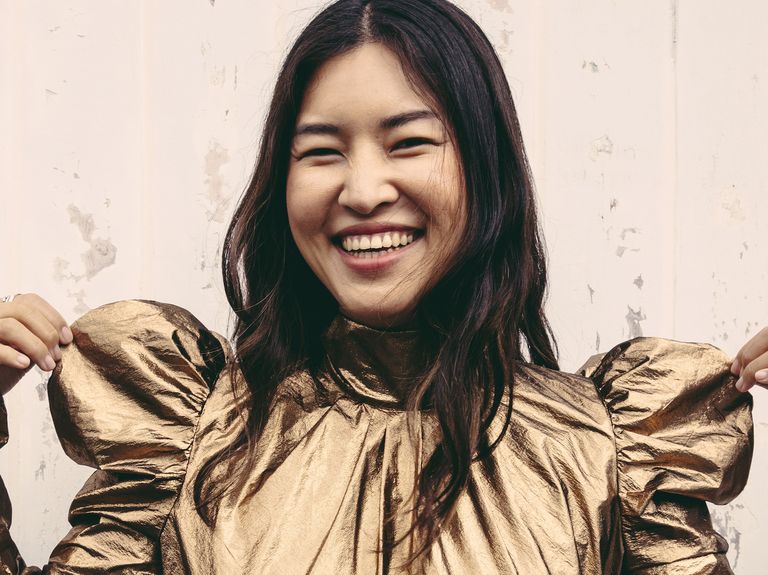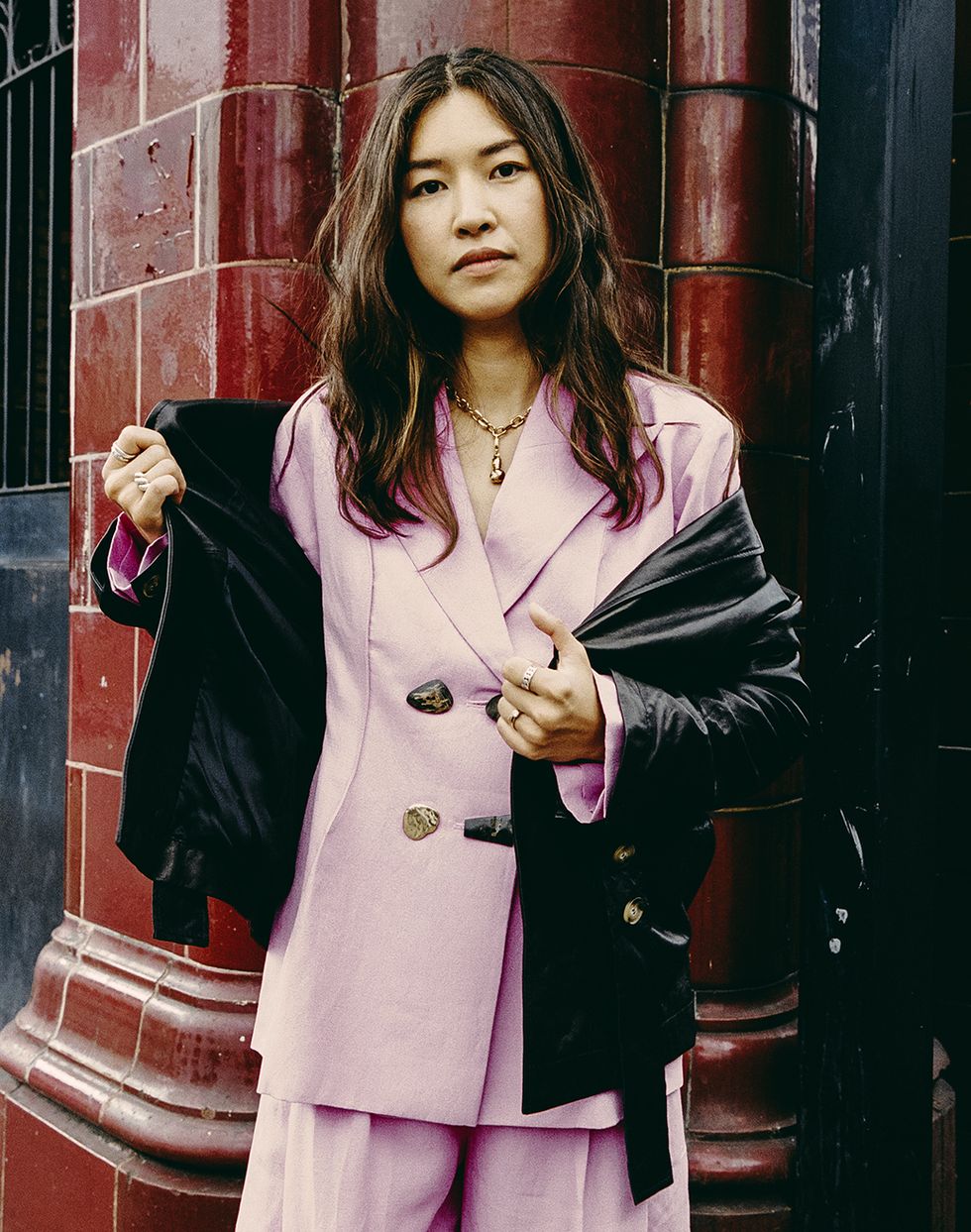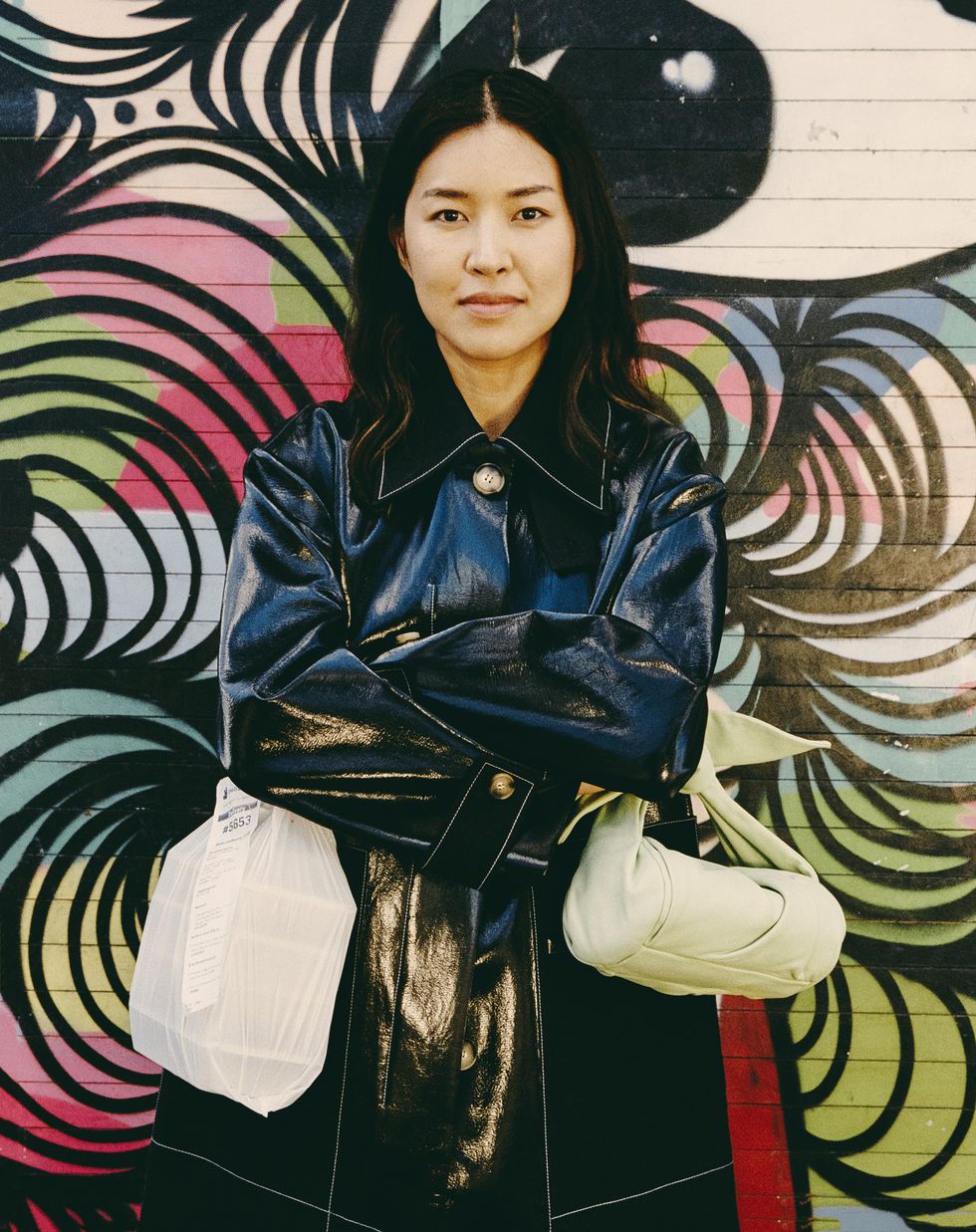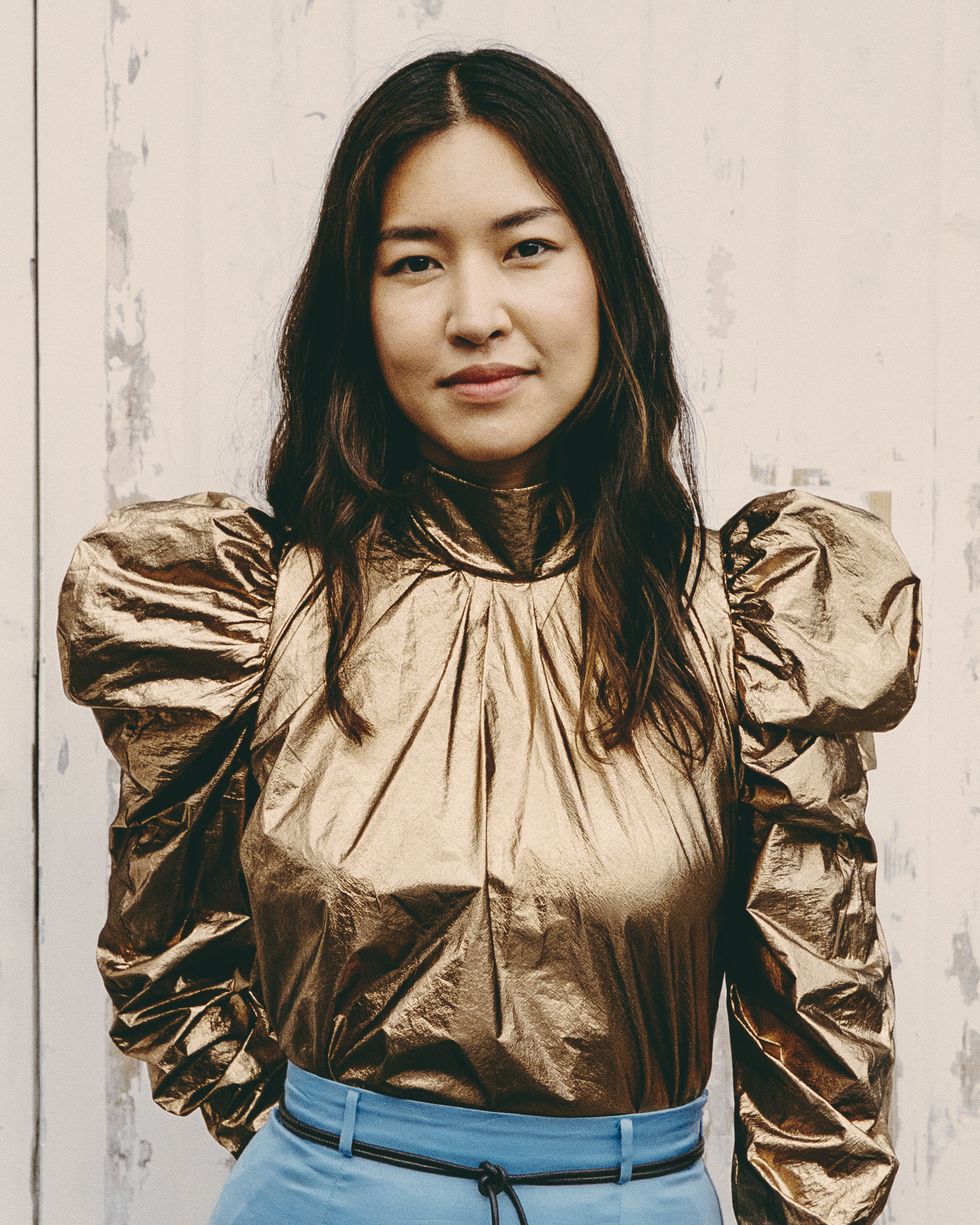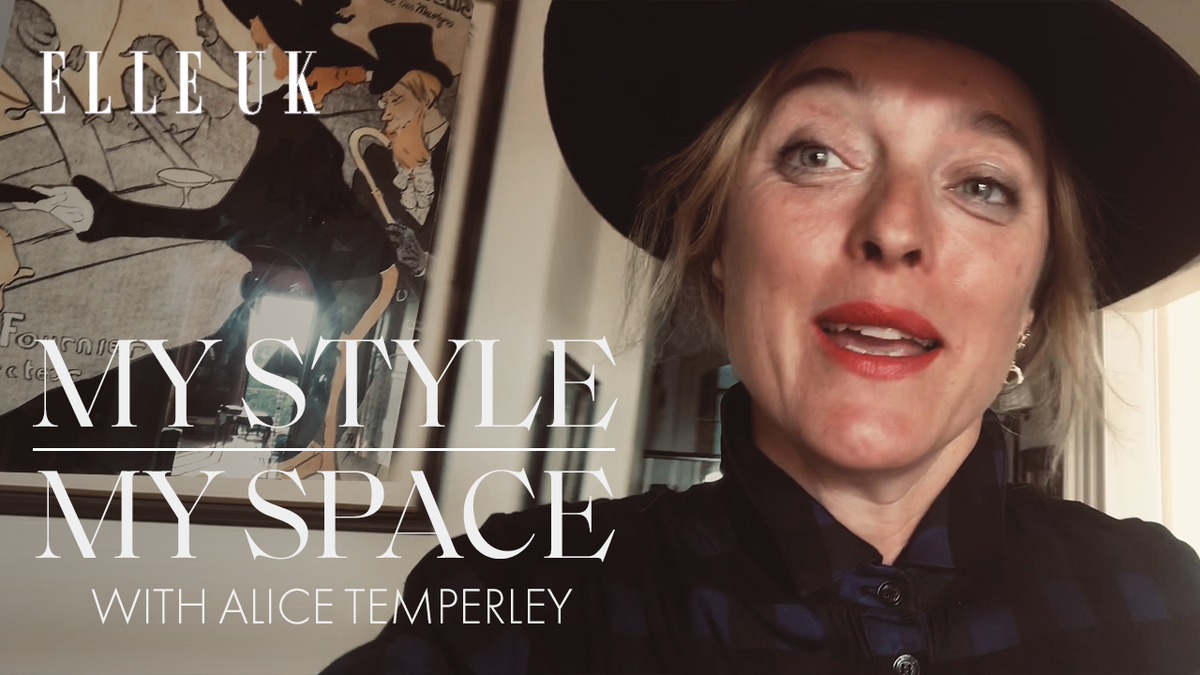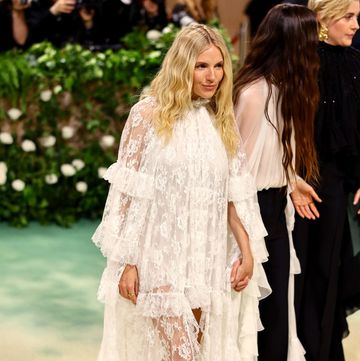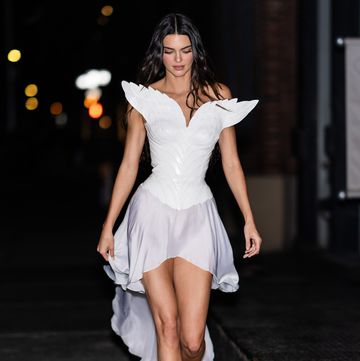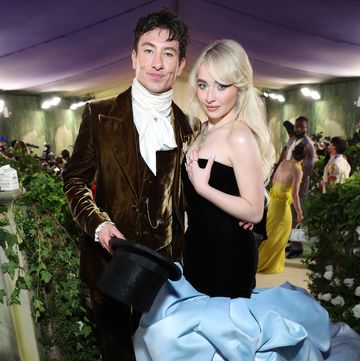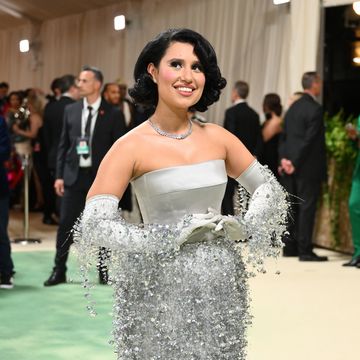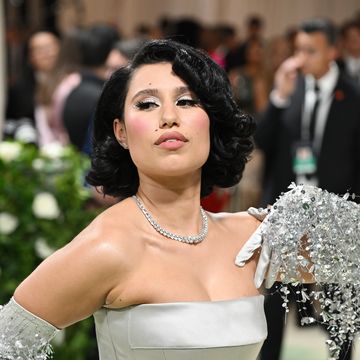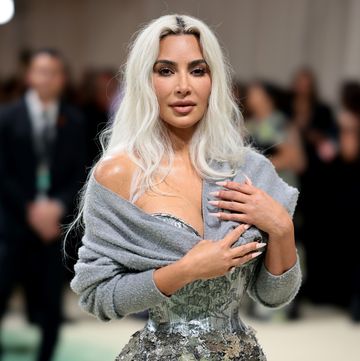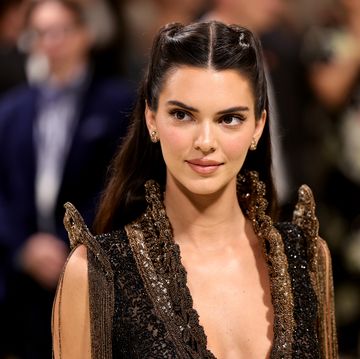If you were to describe Rejina Pyo, you’d reach for the most polite adjectives – sweet, nice or just lovely, ‘so, so lovely’, as she has been described by everyone, from former interns to the most curmudgeonly members of the fashion press.
We meet on one of the hottest days of August, at the end of a marathon six-hour shoot, spread across four locations. Everyone, from assistants to art directors, is exhausted, flush-faced and huffing beneath surgical masks in the stifling heat. Everyone except Pyo, who sits in the centre of it all, cool as a mill pond, with a smile that spreads slowly across her face, reaching her eyes.
If you don’t know Pyo by name, you will almost certainly recognise the styles for which she has become known: easy-to-wear separates, elegant ‘with a twist, a little detail’ that make everyday styles less ordinary. Those, and the puff-shouldered midi-dresses – which have spawned a thousand high-street copycats since Pyo launched her brand in 2014, spreading virally on social media as influencers flocked to post selfies of themselves wearing her signature, statement-silhouette ‘Greta’ dress.
Seen on everyone from Man Repeller founder Leandra Medine to influencer-editors Eva Chen and Kate Foley, Pyo’s styles proved to be Instagram catnip. She has amassed more than 100 stockists worldwide, including Net-A-Porter and Harvey Nichols, as well as a growing list of celebrity fans (with Meghan Markle as the latest addition). Yet 37-year-old Pyo almost packed it all in, after nearly going broke to fund her own business.
‘I suppose I’ve always been quite independent,’ Pyo says, wrinkling her nose, then laughing, while trying to make sense of the decision she made to move 5,500 miles across the globe from South Korea to London in her early twenties – despite having comfortably established a career in her home city. Born and raised in the Gangnam district, Seoul (‘Like the song,’ she says), style was very much in Pyo’s background, with a mother who worked in fashion before turning her hand to interior design and art. ‘My mum had lots of different careers and interests,’ Pyo explains. ‘She loved old antiques, so our house was full of old furniture – always dark brown wood with special little details and random objects. I would go to friends’ houses and see everything was new, with white Ikea furniture and modern lines. I was like, ‘Mum, why is our house like this?!’
It’s a mix of antique details and clean, modern lines that Pyo has since made her USP (square-neck blazers with burnished, old-doorknob-like buttons and sharp, pointed pumps with sculptural heels are among her bestselling pieces). ‘I always wanted to be a fashion designer,’ she says. However, that certainty still came with a few false starts.
After studying art at Hongik University, Pyo followed a straightforward path, working for a mass South Korean retailer. ‘In South Korea, your path is expected to be…’ She hesitates. ‘Whatever is considered the best you can do: a big cooperation; the bigger, the better. But I thought, I just don’t see myself being happy with something so corporate for the next 10 years.’ The Gangnam district is similar to major cities in the West, in so far as scale and pace go, with high-rise buildings that Pyo likens to Manhattan. If anything, it’s faster. ‘There are hardly any holidays, maybe one day for Christmas and no Easter. When I came to the UK, I was like, Another holiday, really?’ This might explain why Pyo often seems so at ease, despite the fashion industry’s frantic pace, with a contagiously calm demeanour.
‘There was pressure to fit in, and if you don’t fit in you’re just a bit weird, sticking out too much,’ she says. Stick out, she did, standing at 5ft 8in tall. ‘By Korean standards, I’m too big. They only really have two clothing sizes, and a lot of [the clothing] is national brands. Even the biggest shoe size is a 38. I thought I was a 38 this whole time. I’m actually a 39,’ Pyo says, laughing.
‘I decided to travel on my own in Europe when I was 21 – no smartphone, no internet, just a Lonely Planet guide – and you had to call a hostel from the train station,’ she recalls. ‘My family isn’t really wealthy, so they couldn’t afford to send me abroad to study.’ However, a few years later, Pyo made the decision to enrol in a year-long course at London fashion school Central Saint Martins – where designers such as Alexander McQueen, John Galliano and Stella McCartney had attended – made possible with money saved while working and the offer to stay with a friend based in London. ‘Coming here in 2008, I never thought I would go back [to South Korea],’ she admits.
She was deemed ‘too gentle’ by tutors at Saint Martins, though. ‘They said, “You’re too soft, I don’t think you can handle it.” I said, “Maybe because I’m soft I can get by. If you’re too stiff, you’re going to break.” They laughed, replying: “Maybe you’re right.”’ Pyo went on to complete a masters in Fashion, graduating in 2011.
Fashion was a very different place in the early 2010s. Instagram had only just launched and influencers, as we now know them, were still using blogs as their primary platform. The internet was yet to fully revolutionise the industry, narrowing the gap between luxury and the average shopper looking for catwalk style at a more accessible price. As a customer, your best bet was the designer-high-street collaboration, which was arguably at its peak in the first half of the decade, with a succession of collections – including H&M with Versace, Marni, Maison Margiela and Isabel Marant – setting shoppers in a tailspin, leaving shelves near-empty.
Pyo herself won the attention of H&M-owned brand Weekday with her 2011 graduate collection, and was invited to collaborate on a capsule collection of block-coloured separates, stocked
in 30 of its stores across Europe. That was quickly followed by the Hans Nefkens Fashion Award, which included a cash prize and six-month residency working on an art exhibition at
the Museum Boijmans Van Beuningen in Rotterdam. While earning acclaim for her independent projects, in the background Pyo was also juggling a day job as the first-ever design assistant to the London-based Serbian designer Roksanda Ilinčić, known for her grand, jewel-toned gowns. She had two options: to continue juggling what was becoming two full-time jobs, or go it alone and commit to launching her own label. ‘Roksanda was like, “Oh my god, that’s an amazing opportunity. Do it. When you finish, you can always come back.”’ But Pyo never did go back – she didn’t have to.
Accessibility is a central tenet of Pyo’s brand, and crucial to her decision to start her own label in 2014. It’s what makes her work so relatable. ‘What I wanted was the luxury fashion that I couldn’t afford. My friends couldn’t afford it either, with one piece costing an entire month’s salary. You’re scared to ruin it,’ she explains. However, if you wanted to launch a brand then, your best bet was positioning yourself as ‘luxury’ (ie, expensive) or ‘contemporary’ (ie, more affordable ‘premium’ styles, such as Acne Studios’ denim or Theory’s suiting). ‘Stores were divided by floors – luxury on one floor, contemporary on another,’ she explains. ‘So I was meeting retailers and they didn’t know where to put me. Sometimes I’d be sitting in the trade fair showroom, wondering why nobody was stopping by. You do think about quitting.’ And she nearly did, until a chance encounter in New York.
‘It was love at first sight,’ says Kate Foley, the super-stylist and former buyer beloved by street-style cameras. ‘We bumped into each other on the street in New York – Rejina is the
embodiment of the Rejina Pyo woman, and looked so effortless and elegant,’ she remembers. Foley, well-connected with the world’s most important editors and influencers, invited Pyo to present a collection at renowned independent boutique Maryam Nassir Zadeh in September 2016, officially entering fashion week with her sweetly priced, artful and architectural
styles. And a wave of influencers and fashion fans were quick to adopt her pieces – particularly those signature statement-shouldered midi-dresses – as their uniform; style that stands out, but at a price that is still reasonably accessible.
‘She really appeals to women who like to make fashion their own; a more individual take,’ adds Elizabeth von der Goltz, Global Buying Director at Net-A-Porter. ‘People probably don’t realise that a lot of [influencers] are paid to wear designer brands. But they were actually buying the pieces,’ Pyo says, her hands pressed to her chest in gratitude. New York Magazine went as far as stating that Pyo’s ‘Greta’ dress, a full-sleeved, cinch-waisted style, was ‘the most popular dress at New York Fashion Week’ in September 2017.
‘She cares about so much more than clothes, and that’s what makes her designs so joyous,’ says journalist Pandora Sykes. ‘They’re for grown women who like confident, colourful pieces that they aren’t always plucking at awkwardly. I have several of her dresses that I pull out time and time again – including when pregnant. Both times!’
Though success for Pyo came at some personal cost. ‘I was pregnant when I showed in New York,’ Pyo says. She was about to give birth to Luka, her son with Irish chef Jordan Bourke (who she met ‘casually, in a bar’ as a student, and with whom she’s published a Korean cookbook). ‘It was getting really busy, and the brand was becoming recognised; lots of things were happening.’ So, no maternity leave. No time off to give birth. In fact, ‘I was on emails the next day,’ she says.
Pyo radiates a quiet warmth, and speaks and moves with a series of small gestures; understated, always polite, with a kind, wide, bright smile and a laugh. Nothing appears to be a big deal – a strand of hair in her face is discreetly waved out of the way while her hand is already raised to sip water, and hardship is always modestly dismissed with a small shrug.
‘You learn the hard way,’ Pyo laughs when I point out that she seems so cool under pressure. It was Luka, now three-and-a-half, who taught her to calm down. (That and, she adds, a steady pile of parenting and non-fiction books: The Book You Wish Your Parents Had Read by Philippa Perry, and Outliers by Malcolm Gladwell.) ‘It was hard; there were no boundaries. My husband and I, his brother and his partner were in a big house that we shared, and we used the downstairs as a studio. I’d work, run upstairs to breastfeed and go downstairs again,’ she says, comically mimicking hurrying between floors. ‘Before, I wasn’t able to detach myself from the brand – if anyone criticised it, I felt like they were criticising me. It wasn’t healthy. I had to learn how to protect myself from stress, as I didn’t want to pass that on to my baby.’ Pyo admits there’s an advantage to treating work so personally, though: many of her collections reflect where she is in life. She makes the clothes women want because she wants them.
Pyo and Bourke have since moved into their own home, a Victorian terrace in north London. She’s feeling more ‘homely’, with the renovations trickling into recent collections: all plush cosy knits, wallpaper prints and heels resembling old banisters. So, what of AW20’s darker, sexier streak? ‘I was feeling that way,’ she says, tilting her head demurely before breaking into a laugh. ‘I feel braver,’ she adds. ‘Becoming a mum must have helped. I think nothing really pains me or scares me now. And it’s a bit boring if you’re pigeon-holed.’ Success, in the form of a British Fashion Award for British Emerging Talent Womenswear in 2019, surely helped with her confidence, too.
Now with a studio near her home, overseeing her team of 14 (four of whom are based in South Korea, where, pre-pandemic, she frequently visited to oversee production), the business is steadily expanding. Pyo has an ‘It’ piece for every category: shoes, handbags (with the ‘Nane’ bow-handled style gaining attention as Meghan Markle’s choice of accessory on International Women’s Day). There’s menswear too, with Pyo launching a unisex line of shirts in spring 2020, having realised she often mixes her own styles with the same shirts as her husband. (She says this while readying herself to leave and changing into a sun-faded Hawaiian-print shirt that she’d stuffed into a canvas tote prior to shooting – the same shirt worn by Bourke in an image posted on Pyo’s personal Instagram earlier that week.)
While the future is uncertain globally, Pyo remains optimistic. ‘You can’t really plan anything these days,’ she says. ‘But I think that’s good, because we need to try and live in the moment.’ And when you’re Rejina Pyo, the moment is yours for the taking.
ELLE's December issue is on newsstands now.
Like this article? Sign up to our newsletter to get more articles like this delivered straight to your inbox.
In need of more inspiration, thoughtful journalism and at-home beauty tips? Subscribe to ELLE's print magazine today! SUBSCRIBE HERE
